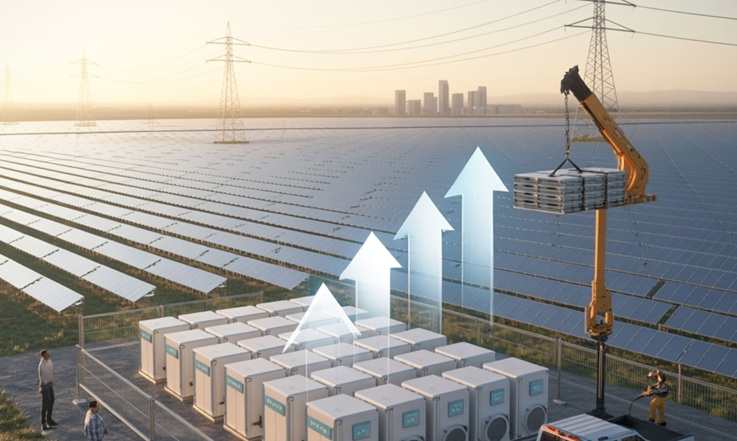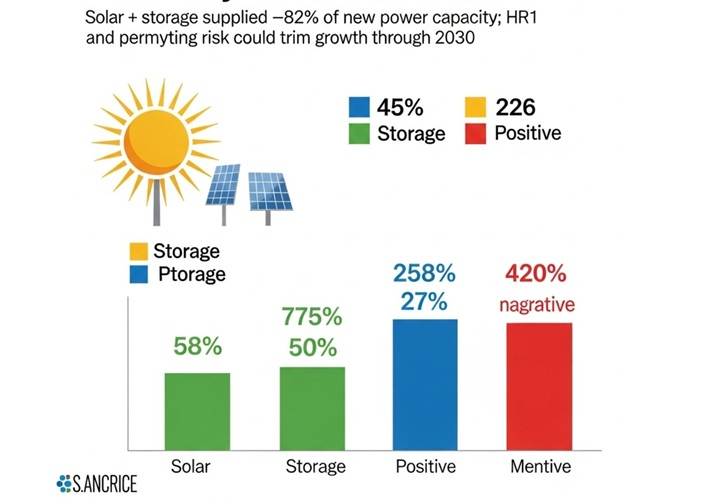US solar just had a banner half‑year. The industry plugged nearly 18 gigawatts (GW) of new solar into the grid, and when you add battery storage, that duo supplied 82% of all new power capacity added nationwide. That’s a jaw‑dropping stat in any political climate. But there’s a catch: the growth curve could flatten unless federal policy whiplash eases. That’s the warning from the Solar Energy Industries Association (SEIA) and Wood Mackenzie in their latest U.S. Solar Market Insight.

- 18 GW of new solar came online in the first half of the year.
- Solar + storage = 82% of all new power capacity added.
- SEIA/WoodMac say federal policy shifts could shave 44 GW off expected solar growth by 2030 (an 18% drop).
- Versus pre‑HR1 forecasts, the shortfall clocks in at 55 GW (about 21% fewer projects by 2030).
- Irony alert: 77% of new solar capacity went to states that voted red, led by Texas, Indiana, Arizona, Florida, Ohio, Missouri, Kentucky, and Arkansas.
- Manufacturing is scaling: 13 GW of new module capacity ramped, bringing U.S. total to 55 GW—but upstream investment froze amid policy uncertainty.
SEIA’s message is blunt: solar and batteries are delivering the majority of new, lowest‑cost power for American families and businesses, but shifting federal rules are chilling private investment right when the grid needs more clean, firm capacity. The trade group says federal actions tied to HR1 and new Department of the Interior (DOI) permitting obstacles could slow or block projects that would otherwise cut bills, strengthen reliability, and create jobs.
- 18 GW of solar added to the grid in H1.
- 82% of all new power capacity came from solar and storage combined.
- 44 GW of expected growth at risk by 2030 from recent federal policy changes.
- 55 GW shortfall by 2030 compared with pre‑HR1 forecasts (−21% projects).
- 77% of new solar capacity came in states carried by Trump.
- 13 GW of new module manufacturing capacity added; total U.S. capacity = 55 GW.
- 0 new upstream manufacturing announcements in Q2 due to policy uncertainty.
- 44 GW of planned projects threatened by a DOI permitting order, with Arizona, California, and Nevada expected to be hit hardest.
44–55 GW of solar growth gone by 2030 is the difference between a grid that keeps pace with demand—and one that faces crunches. Delays mean developers miss tax credit windows and financing gets pricier; costs trickle down to ratepayers. Utilities are retiring old plants. If new capacity doesn’t arrive on time, the grid gets tight during heat waves and cold snaps. Factory build‑outs thrive on clear rules; uncertainty scares capital off the sidelines.
Policy impact
| Category | Before HR1 (forecast) | After HR1 + permitting shifts | What it means |
|---|---|---|---|
| Solar growth to 2030 | Baseline plan | −44 GW (−18%) | Fewer project completions |
| Gap vs. pre‑HR1 | — | −55 GW (−21%) | Bigger long‑term shortfall |
| Manufacturing mood | Strong ramp | Freeze in upstream Q2 | Slower supply build‑out |
Here’s the twist that may surprise folks: 77% of the new solar capacity this year was built in states that voted red. Texas, Indiana, Arizona, Florida, Ohio, Missouri, Kentucky, and Arkansas are among the top installers. Why? Big industrial loads, cheap land, abundant sunshine, and utilities trying to meet demand growth at the lowest cost—solar plus batteries often win that math.
Manufacturing is ramping
The U.S. added 13 GW of new module capacity in the first half of the year, with notable ramps in Texas, Indiana, and Minnesota. That pushes total domestic capacity to 55 GW—real progress toward energy security and supply chain resilience. But in the second quarter, upstream investments (think cells, wafers, polysilicon) stalled as policy signals wobbled. Manufacturers need long lead times, stable rules, and predictable demand to green‑light billion‑dollar lines.

- Tailwinds: Projects already in the pipeline, developers racing tax credit deadlines, and electricity demand jumping thanks to data centers, electrification, and reshoring.
- Headwinds: HR1 impacts, DOI permitting barriers, and broader uncertainty that adds risk premiums to every dollar invested.
SEIA’s leadership argues federal actions are “deliberately stifling investment,” raising costs and risking reliability, even as the market is clearly demanding “reliable, affordable, American‑made energy.” Wood Mackenzie warns that new DOI permitting hurdles could put tens of gigawatts at risk, especially in sun‑rich states that anchor utility‑scale build‑outs. “Further uncertainty from federal policy actions is making the business environment incredibly challenging,” says the research firm.
This isn’t just about power bills—it’s also about America’s competitiveness. Data centers and AI training clusters are hungry for electrons. The fastest, cheapest way to add large amounts of capacity is by pairing solar with storage and strengthening transmission. If projects don’t get permitted and financed on schedule, the U.S. risks slower AI growth and missed opportunities in advanced manufacturing. SEIA’s “grid reliability” agenda calls for a coalition approach across federal, state, and local levels to speed interconnection, modernize permitting, and add batteries where they do the most good.
- Lower bills: When developers can deliver projects on time, solar and storage tend to beat new fossil generation on cost.
- Fewer outages: Batteries smooth the grid during peak demand and extreme weather.
- Local jobs: Construction, electrical trades, operations, and U.S. manufacturing all benefit from steady pipelines.
- Community resilience: Storage can keep critical facilities powered when the grid stumbles.
- Clear the permitting bottleneck: Streamline DOI processes for utility‑scale projects with predictable timelines and standards.
- Lock in stable tax credit guidance: Developers and manufacturers need clarity to price bids and sign contracts.
- Supercharge interconnection reform: Utilities and grid operators should adopt more transparent, first‑ready/first‑served queues and standardized studies.
- Build more wires: Transmission expansions unlock low‑cost solar and reduce congestion costs that show up on bills.
- Support U.S. manufacturing: Encourage upstream (cells, wafers, polysilicon) to match the module boom, with incentives tied to long‑term certainty and domestic content.
The U.S. solar story is both impressive and fragile. On one hand, developers just delivered a massive wave of clean power; on the other, policy turbulence threatens to shave off the next wave before it hits the shore. The math is simple: America needs more reliable, affordable power. Solar and batteries are delivering that today. With stable rules and smarter permitting, they can deliver even more—keeping bills down, lights on, factories humming, and the country competitive in the global race for AI and advanced industry. If lawmakers want lower costs and a sturdier grid, the playbook is right in front of them: let solar and storage do what they do best, and get the red tape out of their way.
Related Post




